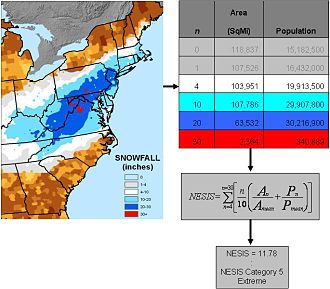- Northeast Snowfall Impact Scale
-
The Northeast Snowfall Impact Scale was created to measure snowstorms in the U.S. Northeast in much the same way the Saffir-Simpson Hurricane Scale records hurricane intensity and the Enhanced Fujita Scale with tornadoes.
Contents
The Scale
NESIS, as it has been dubbed by creators Paul Kocin of The Weather Channel and Louis Uccellini of the National Weather Service, classifies storms in one of five ways that range from Notable (the weakest designation) to Significant, Major, Crippling, and Extreme. They created this measuring system due to the effects these storms have on the economy and transportation throughout the major cities in the Northeastern United States as well as the country as a whole.[1][2]
Category NESIS Value Description 1 1 — 2.499 Notable 2 2.5 — 3.99 Significant 3 4 — 5.99 Major 4 6 — 9.99 Crippling 5 10.0+ Extreme The variables measured on the scale include area, amount of snowfall, and the number of people living in the path of the storm. These numbers are calculated into a raw data number ranging from "1" for an insignificant fall to over "10" for a massive snowstorm. Based on these raw numbers, the storm is placed into one of the five categories. The largest NESIS values result from storms producing heavy snowfall over large areas that include major metropolitan areas. Only two historical storms—the 1993 Storm of the Century and the North American blizzard of 1996—are in the Category 5, with a NESIS value higher than 10.
The northeast is the first region in the U.S. to use a system that measures the impact of snowfall because it is so densely populated. The scale also allows for meteorologists to predict how long airport delays caused snowstorms will last and when things will become normal afterward. According to Uccellini, NESIS will be used to reevaluate recent snowstorms and measure their impact and not as forecasts such as the ones that are created for hurricanes.
Example
By using an example of the area from Washington D.C. to Boston, a Notable Category 1 snowfall would have to drop anywhere from 4 to 10 inches of snow to fall in the category. A Category 2 would affect same area but more people with more than 10 inches of snow on Mid Atlantic Seaboard. A Category 3 would bring about 10-20 inches of snow and affect millions of people in the process.
See also
- List of NESIS storms
- Fujita Scale
References
External links
- Overview
- Northeast Snowfall Impact Scale
- ScienceDaily Ranking Winter Storms: Meteorologists' New Scale Will Help in Emergency Planning January 1, 2007 (accessed 11 Nov 2007)
Categories:- Weather prediction
- Hazard scales
Wikimedia Foundation. 2010.

